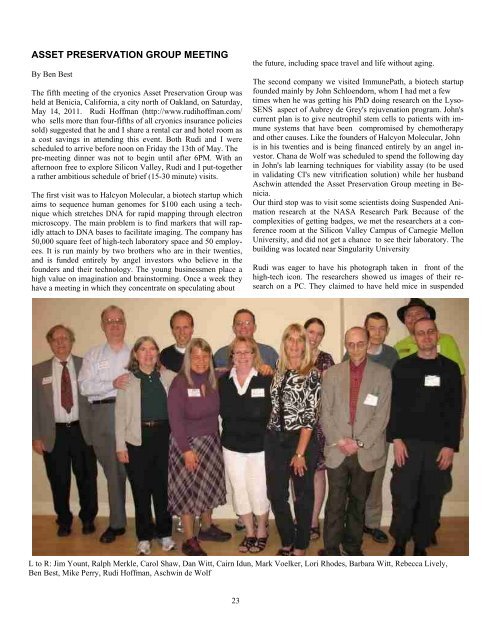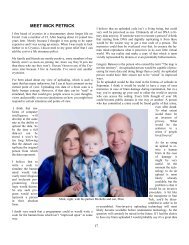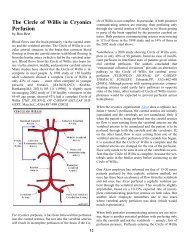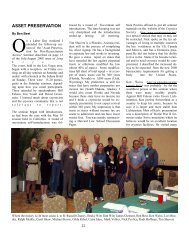ASSET PRESERVATION GROUP MEETING - Cryonics Institute
ASSET PRESERVATION GROUP MEETING - Cryonics Institute
ASSET PRESERVATION GROUP MEETING - Cryonics Institute
Create successful ePaper yourself
Turn your PDF publications into a flip-book with our unique Google optimized e-Paper software.
<strong>ASSET</strong> <strong>PRESERVATION</strong> <strong>GROUP</strong> <strong>MEETING</strong><br />
By Ben Best<br />
The fifth meeting of the cryonics Asset Preservation Group was<br />
held at Benicia, California, a city north of Oakland, on Saturday,<br />
May 14, 2011. Rudi Hoffman (http://www.rudihoffman.com/<br />
who sells more than four-fifths of all cryonics insurance policies<br />
sold) suggested that he and I share a rental car and hotel room as<br />
a cost savings in attending this event. Both Rudi and I were<br />
scheduled to arrive before noon on Friday the 13th of May. The<br />
pre-meeting dinner was not to begin until after 6PM. With an<br />
afternoon free to explore Silicon Valley, Rudi and I put-together<br />
a rather ambitious schedule of brief (15-30 minute) visits.<br />
The first visit was to Halcyon Molecular, a biotech startup which<br />
aims to sequence human genomes for $100 each using a technique<br />
which stretches DNA for rapid mapping through electron<br />
microscopy. The main problem is to find markers that will rapidly<br />
attach to DNA bases to facilitate imaging. The company has<br />
50,000 square feet of high-tech laboratory space and 50 employees.<br />
It is run mainly by two brothers who are in their twenties,<br />
and is funded entirely by angel investors who believe in the<br />
founders and their technology. The young businessmen place a<br />
high value on imagination and brainstorming. Once a week they<br />
have a meeting in which they concentrate on speculating about<br />
the future, including space travel and life without aging.<br />
The second company we visited ImmunePath, a biotech startup<br />
founded mainly by John Schloendorn, whom I had met a few<br />
times when he was getting his PhD doing research on the Lyso-<br />
SENS aspect of Aubrey de Grey's rejuvenation program. John's<br />
current plan is to give neutrophil stem cells to patients with immune<br />
systems that have been compromised by chemotherapy<br />
and other causes. Like the founders of Halcyon Molecular, John<br />
is in his twenties and is being financed entirely by an angel investor.<br />
Chana de Wolf was scheduled to spend the following day<br />
in John's lab learning techniques for viability assay (to be used<br />
in validating CI's new vitrification solution) while her husband<br />
Aschwin attended the Asset Preservation Group meeting in Benicia.<br />
Our third stop was to visit some scientists doing Suspended Animation<br />
research at the NASA Research Park Because of the<br />
complexities of getting badges, we met the researchers at a conference<br />
room at the Silicon Valley Campus of Carnegie Mellon<br />
University, and did not get a chance to see their laboratory. The<br />
building was located near Singularity University<br />
Rudi was eager to have his photograph taken in front of the<br />
high-tech icon. The researchers showed us images of their research<br />
on a PC. They claimed to have held mice in suspended<br />
L to R: Jim Yount, Ralph Merkle, Carol Shaw, Dan Witt, Cairn Idun, Mark Voelker, Lori Rhodes, Barbara Witt, Rebecca Lively,<br />
Ben Best, Mike Perry, Rudi Hoffman, Aschwin de Wolf<br />
23
animation for 20 hours- much longer than Mark Roth. They did<br />
this by having found a protein that affects thermoregulation centers<br />
in the brain, and use this in conjunction with hydrogen sulfide.<br />
They had ambitions of achieving lower temperatures, and<br />
were worrying about such things as cold denaturation of proteins.<br />
An even greater concern, however, was funding. NASA's<br />
funding priorities are highly unpredictable, and I could see that<br />
the researchers had hopes of getting money from the cryonics<br />
community. I wish I had the means to help them. Depressed me<br />
tabolism technologies might be useful for limiting ischemic<br />
damage for cryonics patients in various situations.<br />
After picking-up Mike Perry at the Oakland Airport, Rudi and I<br />
dropped by BioTime, Inc where we were met by Judy Segall.<br />
Judy gave us a tour of the labs, which included a visit with Hal<br />
Sternberg and a researcher whom everyone calls"Tumbleweeds"<br />
because of his long frizzy hair. BioTime continues to earn about<br />
a million dollars per year from royalties from the blood replacement<br />
Hextend but with Michael West involved, is now getting<br />
most of its money as grants from the State of California for stem<br />
cell development. Research-only stem cell products can generally<br />
be marketed without FDA approval.<br />
After the BioTime tour, Judy led us to the Trans Time facility<br />
where her husband Paul Segall is being stored in liquid nitrogen<br />
along with two neuros and two pets. BioTime staff take turns<br />
topping off the dewar inwhich the patients are stored. From<br />
Trans Time we were able make our way to Benicia, where Dan<br />
and Barbara Witt were hosting the pre-meeting dinner at the<br />
head of the table:<br />
The cryonics Asset Preservation Group was again organized by<br />
Cairn Idun (the creator of the group), funded by the Life Extension<br />
Foundation (Bill Faloon), and this (the fifth) meeting was<br />
hosted by Dan and Barbara Witt. As founder of the Life<br />
Extension Foundation, Saul Kent is helping to finance this<br />
Group, but he has yet to attend a single meeting. He made some<br />
comments during a revival trust discussion at the Suspended<br />
Animation conference that are worth mentioning, however.<br />
Saul said that he has heard many cryonicists say that they don't<br />
care if they are reanimated penniless, as long as they are revived.<br />
Saul's interpretation of this statement is that such people don't<br />
think it is likely that cryonics is going to work. Saul asked who<br />
would want to go to Paris, France without taking any money.<br />
After introductions, the presentations began with Ralph Merkle's<br />
updates on the Alcor Model Trust, which I described in my review<br />
of the previous year's meeting:<br />
No problems have been found with compatibility of Alcor's 501<br />
(c)3 with the Alcor Model Trust. On the other hand, Ralph<br />
Merkle and his wife Carol Shaw are still the only people with<br />
the Alcor Model Trust, and their trusts remain unfunded. The<br />
Trust is revocable pre-mortem, and becomes irrevocable<br />
upon legal death of the Settlor (Grantor). Unlike ordinary trusts<br />
that have three participants (Settlor, Trustee, and Beneficiary),<br />
24<br />
perpetual trusts (trusts in jurisdictions having no law against<br />
perpetuities often have a fourth participant: Trust Protector having<br />
the power to change trustees and even beneficiaries. The<br />
revived cryonicist must be recognized as the beneficiary, which<br />
a cryonicist Trust Protector is expected to do.<br />
In the Alcor Model Trust there are three trust protectors (called<br />
"trust advisors"), two of whom are appointed by the Settlor, with<br />
the third appointed by Alcor. Subsequent trust protectors could<br />
all be appointed by Alcor. Alcor requires that all trust protectors<br />
sign a Relative's Affidavit. Both Alcor and the chosen institutional<br />
trustee (which administers the trust after the trust becomes<br />
irrevocable) insert blocks of text in the trust which delimit duties<br />
and requirements. (Vanguard as the trustee of Ralph's trust will<br />
handle no assets other than cash, but other trustees may have<br />
different policies.) Alcor Members wanting the trust would pay a<br />
one-time fee of $500 to Alcor plus plus additional legal fees<br />
Alcor may have to pay for legal review, plus any additional legal<br />
fees the Member may want to spend for attorneys to<br />
customize the trust for their own purposes.<br />
Alcor encourages those creating revival trusts to have the trusts<br />
make annual donations to Alcor from trust income, which will<br />
increase Alcor's interest in the trust. Alcor is expected to be responsible<br />
for revival, which will require funding research<br />
into reanimation methods, as well as subsequent application of<br />
those methods. As further revival incentive, the Model Trust lets<br />
the Settlor assign a percentage of trust assets to be given to<br />
Alcor upon successful revival of the patient.<br />
When Ralph presented the Alcor Model Trust to a session at the<br />
Suspended Animation conference the following week, one longtime<br />
Alcor Member complained that the Trust wasn't the turnkey<br />
solution he had been hoping for. Leaving Alcor Members the<br />
responsibility of finding their own institutional trustee and the<br />
management fees institutional trustees would charge, would<br />
exclude all butthe very wealthy. Ralph answered that the Alcor-<br />
Model Trust is a first step. Bill Faloon expressed the hope that a<br />
group trust could be formed which Alcor Members with as little<br />
as $50,000 could join without going to a lawyer.<br />
The next presentation was Bill Faloon describing his project to<br />
form a "Committee of Perpetual Guardians" to serve as trust<br />
protectors of perpetual revival trusts for cryonicists. Bill imagines<br />
that there will someday be hundreds of revival trusts created<br />
by wealthy cryonicists who will want to preserve their wealth<br />
for their revival. Some of the income from such trusts would be<br />
used for research to develop reanimation technologies. The<br />
Committee of Perpetual Guardians would protect the interests of<br />
the beneficiaries by overseeing the trustees, directing investments,<br />
and allocating trust income to promising proposals for<br />
reanimation research.<br />
Bill proposed establishing the Committee of Perpetual Guardians<br />
as a subunit of the Asset Preservation Group. Bill determined<br />
that committee members could best be protected from<br />
liability if the committee was a nonprofit corporation of the
State of Virginia, where officers and directors have no liability if<br />
they are not financially compensated. Bill drafted a proposed<br />
set of ByLaws for the new organization, which would have a<br />
President and Secretary-Treasurer elected by the Committee.<br />
Lori Rhodes discussed the "medico-legal need for a cryonicsfriendly<br />
autopsy". Lori estimated that about a tenth of cryonics<br />
cases involve autopsy. She seeks legislation that would protect<br />
cryonicists from destructive autopsy of the brain, and that would<br />
ensure timely treatment of cryonics cases by a medical examiner.<br />
Coroners typically have a backlog of bodies that they must<br />
autopsy, which can take days. Although medical examiners<br />
might have no personal objection to elevating cryonics cases to<br />
the highest priority, they would prefer court rulings or legislation<br />
so that they could not be challenged for deviating from a "first<br />
come, first serve" priority list.<br />
Aschwin de Wolf argued that by establishing that cryonics patients<br />
are not dead they could own their own assets and have<br />
bank accounts. He reprinted the written version of his presentation<br />
on his Depressed Metabolism blog: "Neural cryobiology<br />
and the legal recognition of cryonics cases"<br />
Peggy Hoyt is a lawyer with extensive experience in estate law.<br />
Peggy extoled the benefits of Delaware as situs for trusts, saying<br />
that Delaware is a leader in trust law innovation. She gave the<br />
example of Leona Helmsly leaving $12 million in trust for her<br />
dog which a New York judge reduced to $2 million. Peggy said<br />
that Delaware law is more conscious of honoring the intent of<br />
trusts -- respecting the wishes of Settlors.<br />
Russell Cheney gave each participant a copy of the book TO<br />
OUR CHILDREN'S CHILDREN as an aid to collecting memories.<br />
Russell said that<br />
"memory is our most<br />
important asset". Saving<br />
memories in diaries could<br />
assist in restoring personality<br />
in revival. Russell<br />
noted that memories are<br />
more than a collection of<br />
facts -- context, impressions,<br />
and sensations are<br />
essential aspects of<br />
memories. A complete<br />
picture of an individual<br />
will include mannerisms,<br />
attitudes, etc.<br />
Rebecca Lively spoke on<br />
protecting cryonics arrangements<br />
from family<br />
members. She warned<br />
that family members who<br />
are otherwise indifferent<br />
about cryonics can become<br />
antagonistic to the cryonics<br />
25<br />
arrangements if they see that it will mean they get less money.<br />
Financial rewards to family members if a cryopreservation goes<br />
well would create more desireable incentives. Rebecca advocates<br />
updating of cryonics documents because contracts that are<br />
decades old are less convincing of a person's intentions at the<br />
time of legal death.<br />
Mike Perry updated his previous year's report on "Options for<br />
Members with Brain Deteriorating Disorders". In Arizona (and<br />
probably most states) voluntary stopping of eating and drinking<br />
is a means of avoiding autopsy only if done by a person with<br />
a terminal illness. For a healthy person, it would be classified as<br />
suicide, mandating an autopsy. Most alarming is the fact that<br />
Alzheimer's Disease does not qualify as a terminal illness because<br />
it is too slow.<br />
My own presentation was about "Offshore Financial Services<br />
for Cryonicists". I had researched this subject in the 1990s, and<br />
felt that it should be a matter of interest for this Group. So I did<br />
some internet searches to update and expand my knowledge. I<br />
made no pretense of practical experience, indicating that serious<br />
investigation should be made preliminary to serious action.<br />
Restrictive Bank Licenses are not difficult to obtain in many<br />
offshore jurisdictions such as the Bahamas. I suggested that cryonicist-owned<br />
banks could serve as trustees who would recognize<br />
the validity of legally dead cryonicists as beneficiaries.<br />
Moreover, trust income in many offshore jurisdictions is taxfree,<br />
whereas US federal tax amounts to about a third of trust<br />
income. On the other hand, only a few offshore centers have no<br />
law against perpetuities because it is the US Generation Skipping<br />
Tax that has provided the incentive for 23 states to allow<br />
perpetual trusts in order to attract the wealth of dynasty trusts to<br />
their states. There are other mechanisms, however, for establishing<br />
the equivalent of perpetual trusts offshore. The Obama administration<br />
wants to eliminate perpetual trusts on a federal<br />
level ) so diversification of assets between onshore and offshore<br />
seems most prudent.<br />
Rudi Hoffman spoke on "Seven Silly Superstitions About<br />
<strong>Cryonics</strong> Trusts", which he had posted here on CIYG:Rudi says<br />
that cryonics trusts are affordable by most people for the same<br />
reason that cryonics is affordable:life insurance. A cryonics trust<br />
can be the beneficiary of a life insurance policy. I don't believe<br />
that life insurance companies are giving-away money -- in most<br />
cases they will make more on premiums and investment income<br />
than they will give to beneficiaries. During his presentation,<br />
Rudi was convinced by some of us to stop using the word<br />
"suspension" to mean "cryopreservation".<br />
During one of the breaks, Dan Witt (who was hosting the Group<br />
and is an Alcor Member) approached me to tell me how much he<br />
looks forward to receiving LONG LIFE, adding that he enjoys it<br />
more than Alcor's CRYONICS magazine. LONG LIFE Editor<br />
John Bull should take note of the fact that there are many people<br />
who appreciate his good work, despite the fact that they rarely<br />
express their appreciation to him.—- Ben Best






